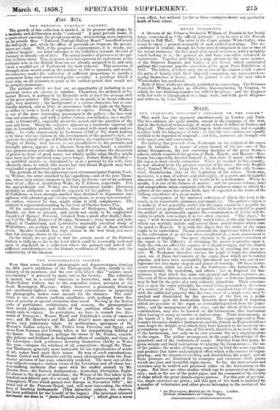THE PHOTOGRAPHIC SOCIETY.
More than oven hundred photographs and daguerreotypes forming the fifth year's exhibition of the Photographic Society, testify to the industry of its members, and the zest with which this "science made entertaining" i8 pursued by many not in the Society. The collection ' is opened, not in a central situation as heretofore, such as the Old Water-Colour Gallery, but in the somewhat remote precincts of the South Kensington Museum ; where, however, a pleasantly fitted-up and excellently-lighted room, with every convenience in inspecting the photographs, makes some amends for the distance. The exhi- bition is one of almost uniform excellence, with perhaps fewer fea- tures of novelty or special attraction than usual. Moving in the beaten paths of portraiture, architecture, and scenery, the photographers show sound judgment, and little of that ambition which too com- monly ends in vagary. In portraiture, we have to remark two like- nesses of Tennyson ; Messrs. Maull and Polyblank's series of eminent men ; and Mr. Howlett's and Mr. Lake Price's more special series of artists, very judiciously taken. In architecture, specimens of Dr. Murray's Indian subjects, Mr. Frith's from Palestine and Egypt, and views from Resenau and Coburg taken at the sympathizing bidding of the Queen. In landscape, perhaps the views of Mr. Fenton, remark- ably delicate and brilliant in background effects of sunlight, and those of Mr. Llewelyn,—both gentlemen devoting themselves chiefly to Wales this year,—surpass the witchery of all competitors ; though Mr. Thur- ston Thompson, generally more noticeable for his reproductions of works of art, comes hard upon their traces. By way of such reproductions, Messrs. Caldesi and Montecchi exhibit many photographs from the Man- chester pictures of last year, admirably rendered. The more out-of-the- way subjects comprise various views of the Leviathan and all about her; deer-stafEng incidents (fine sport with the stuffed animal) by Mr. Horatio Ross ; the Siamese Ambassadors; Australian Aborigines, fright- ful almost to the degree of diabolism ; • the Waves of the Sea taken in the hundred-and-fiftieth part of a second, and "a Photometeorograph of the Atmospheric Wave which passed over Europe in November 1854"; the bridal veil of the Princess Royal, and, still more interesting, the whole bevy of kneeling bridesmaids. (This attractive subject, we observe, has been published for the benefit of the lieges.) The principal coloured specimens are done in "photo-Flemish painting" ; which styes a warm
even effect, but without (so far as these examples show) any particular broth of local colour.


































 Previous page
Previous page